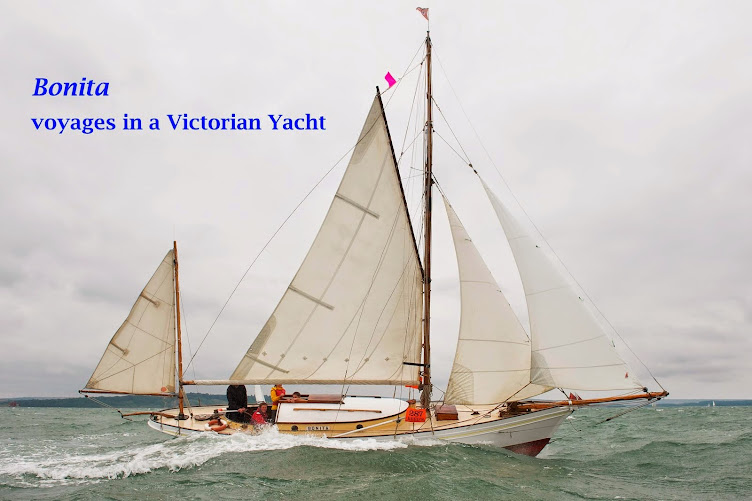On Monday we were joined in Dublin by Jon, and D disappeared to see some friends in Belfast. Jon is an experienced sailor but hasn't previously sailed on a gaffer. However he soon grasped the basic principles of 19th century sailing.
The OGA are gathering in Dublin for a big party at the weekend but we felt we should press on to keep open the option of going round the North of Scotland if the weather holds. To achieve that we should hope to be in Scotland by 2 June. Wherever we go there seems to be discussion as to whether these long periods of mostly northerly winds are due to global warming, and maybe northerlies will displace the south westerlies as the usual prevailing wind over the British Isles.
Jon and I left Dublin about midday and had a good sail with mostly fresh Southerly winds up to Carlingford Lough, on the border between Northern Ireland and Eire. We arrived outside the Lough after dark and for a while waited hove-to outside wondering if we should wait for high tide. I think maybe we were a bit spooked by the fearsome descriptions in the almanac and pilot book: a narrow, difficult rock strewn entrance, and unpredictable strong tides. However we decided we couldn't wait for ever and motored in on the flood tide. Its fine so long as you don't try to cut any corners.
We anchored for the night and in the morning woke in a spectacularly pretty anchorage surrounded by mountains with their tops lost in the mist. We pulled up the anchor and left a little before low water. This was a mistake - we should have left earlier. The tide turned when we were in the entrance channel and a strong flood tide started almost immediately. It took all the power of Bonita's elderly engine to get us out and at times were barely moving.
After this adventure we spent the next few hours in sunshine sailing and motorsailing past a very scenic coast until we arrived at Ardglass. This is a very small fishing and yachting harbour in a rocky inlet in the coast. However it has everything you need (except decent wi-fi) and everyone is very friendly. There were lots of other visiting yachtsmen, some also struggling with persistent northerly winds. D rejoined us there and we spent Wednesday (North to Northwest force 5-6) exploring the town and surrounding area.
Highlights included the seals sitting on rocks in the harbour and the chandlers shop. Fishing port chandlers are always very different from the sort of chandlers you find in yacht marinas and they sell practical looking gear you can put your trust in at reasonable prices.
The weather tomorrow is forecast much the same so we may get to know Ardglass quite well. Maybe the other gaffers were right to stay in Dublin. There are rather more distractions there to compensate for a long stay.
 This morning we listened to the 0520 shipping forecast-not much better, NW 5-6. However we had clear skies and virtually no wind; so we turned the boat round and left the cosy little harbour at Ardglass and this blog is written as we motor past
This morning we listened to the 0520 shipping forecast-not much better, NW 5-6. However we had clear skies and virtually no wind; so we turned the boat round and left the cosy little harbour at Ardglass and this blog is written as we motor past














+Crop.jpg)














